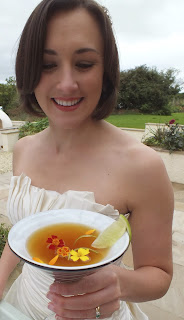I'm not sure whether it is because the weather has been kinder to us this summer or whether is it because people are growing more adventurous about eating flowers but we've had a lot of flowers going out all over the country for cocktails and other summer drinks this year. We have edible flowers heading to London for the cocktail set; to smart catering companies for corporate events and weddings; to one of my favourite customers who is producing a cocktail book next year (but more on that later) and also directly to brides for their wedding drinks.
Maddocks Farm Organics edible flowers also appeared in cocktails on the sofa at RHS Chelsea Flower Show where they were enjoyed by Alan Titchmarsh and Joe Swift and in Lavender cocktails on Sunday Brunch where they were tried by the lovely Simon Rimmer, Tim Lovejoy and their guest, Olympic Athlete, Christine Ohuruogu.

My favourite wedding of 2013 was that of the lovely Carla and Nick . Carla's fabulous mum Marion and her partner Cliff have been working at Maddocks Farm Organics for nearly18 months under the WWOOFing scheme so they are very much part of the family and Carla and Nick's wedding was the first opportunity for Maddocks Farm Organics to grow traditional wedding flowers for Carla's bouquet and to decorate the venues instead of just the usual edible flowers - extremely nerve wracking stuff but the bride was extremely happy and Marion did a wonderful job of arranging everything.
Edible Flowers in your Wedding Drinks
Edible flowers work brilliantly in Wedding drinks
irrespective of whether your wedding is a formal ‘champagne all the way’ kind
of do or whether you are casually pitching a teepee in the back garden and
opting for the DIY route.
Edible flowers come in all shapes and sizes
and add a wonderful sense of glamour and celebration to Weddings and other
special occasions. Pimms has long been
associated with the beautiful blue stars of borage flowers and tagetes work well citrus based drinks.
Snapdragons are wonderful at ‘snapping’ onto the rim of glasses and work
particularly well with very fizzy drinks such as champagne. A confetti of
lovely petals will make any drink look appealing and brides should opt for
smaller rather than larger blooms with drinks so that they compliment rather
than compete with the drink.
As well as using flowers whole to garnish
drinks, petals can also be crushed with salt or sugar to coat the rim of
glasses for cocktails. They then form little jewels of flavour and colour that
are just stunning.
Edible flowers are also wonderful set in
ice either on their own or with mint to add some lovely colour and flavour to
drinks and these can be done well in advance to be added to the drinks at the
last minute. It is worth noting that ice cubes don’t have to be made purely of
water that just dilute the drinks as they melt. I had a wonderful Gin based
cocktail a few weeks back which had ice cubes made from Elderflower Cordial that
released its wonderful flavour and fragrance as it melted changing the drink
from one thing to another. Lemon juice can be added along with the flowers or
lime or ginger. It’s entirely up to you.
Thank you to our lovely real life bride
Carla and her mother Marion for allowing the photos. All photos takes by
Maddocks Farm Organics using our edible flowers which have also featured in
cocktails at Chelsea Flower Show and on Channel 4s Sunday Brunch. Details of
our edible flowers can be found at www. maddocksfarmorganics.co.uk .
You can order edible flowers for cocktails or drinks direct from our on line shop www.maddocksfarmorganics.co.uk - http://www.maddocksfarmorganics.co.uk/cocktail_box.html















